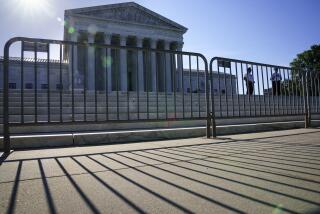Op-Ed: How activist judges increase your taxes
- Share via
In 1977, writing in the Harvard Law Review, Supreme Court Justice William Brennan Jr. exhorted state judges to embrace activist interpretations of the law. The high court had taken a frustratingly conservative turn, Brennan noted. He encouraged state judges to find in state constitutions and laws language that would guarantee citizens “even more protections” than those provided by the U.S. Constitution.
We are still paying for Brennan’s exhortation today.
His essay helped inspire a “positive rights” revolution in state courts. Over the 37 years since Brennan’s appeal, a number of state high courts have aggressively used vague state constitutional language — referring, say, to the general welfare — to force legislators to spend billions of dollars on new entitlements, particularly in education.
Since the early 1980s, the country has seen a tide of “equity” funding lawsuits in which plaintiffs have sought extra state spending in poorer school districts to address funding gaps with wealthier areas. Soon, plaintiffs were arguing that states needed not only to ensure spending equity but to provide an “adequate” education for all children, including those from disadvantaged families — a goal that has further driven spending.
Take the case of Kentucky. In 1984, school superintendents there sued for more funding, seizing on a guarantee of an “efficient” system of public schools in the state’s constitution to challenge school spending there. A trial judge eventually ruled that Kentucky’s General Assembly had failed to provide sufficient resources for efficient public education. But to finance the court’s vision, the state, with a budget of only $8.8 billion at the time, raised taxes by $1.3 billion annually. Within five years, Kentucky’s tax burden jumped from 27th in the nation to 12th-highest among the states.
Education outcomes rose far less impressively. Kentucky students’ scores have increased over the years on the National Assessment of Educational Progress, or NAEP, tests, but those gains largely mirrored national increases. Perhaps more important, given that the court’s push to reduce funding inequities was about improving disadvantaged students’ life chances, the achievement gap between African American and white students hasn’t shrunk in Kentucky. Even on its own spendthrift terms, the judicial campaign to improve schools failed.
Without waiting for the academic results of Kentucky’s massive funding increases, judges in other states also rushed to compel higher school spending, viewing expensive new buildings and additional programs in themselves as signs of improvement. Spending became a de facto measure of success.
A New York judge ordered the state and the city, already spending more than $12 billion on schools (or about $10,500 per student), to hike spending by a jaw-dropping $5.6 billion a year. An appeals court later reduced that amount, but in 2006, Gov. Eliot Spitzer agreed to boost Gotham school spending by $5.4 billion over a four-year period. The money helped fuel an increase in per-pupil spending to $19,000 by 2013. But, as in Kentucky, the flood of new money did little to improve student achievement. Scores on NAEP tests for New York City eighth-graders went up a bit, but less than in other big cities.
One reason for the disconnect between higher funding and results may be other shortcomings in the New York City school system, ignored by the courts: fiscal waste, the lack of an effective teacher evaluation process and rich employee pension and healthcare benefits that consume a growing portion of funding.
While the courts are supposed to provide checks on legislative power, such cases remind us that the judiciary has few checks on its own power. In 1995, the Wyoming Supreme Court interpreted the state constitution’s “thorough and efficient” clause regarding public education to mean that government must build an educational system that is “the best that we can do” — and then, with breathtaking arrogance, added that “lack of financial resources will not be an acceptable reason for failure.”
From 1995 through 2007, the court kept the pressure on Wyoming, and school spending grew by 130% per pupil, driving the state from 15th to sixth in the nation in school expenditures, according to U.S. Census data. Yet the payoff is again hard to see.
As if all this weren’t enough, liberal judges and legal scholars are calling for state courts to push the positive rights agenda even further by guaranteeing such things as minimum welfare payments and government subsidies for food, clothing, housing and medical care to every citizen. But the problem, of course, is that while courts can order states to pay for new material rights, they can’t magically supply the money. Typically, advocates brush the problem aside by observing that the United States is a rich country and can afford the bill.
Constraining state judicial activism won’t be easy. Reform must begin in law schools, where faculties are overwhelmingly liberal and friendly to an activist judiciary (as long as it’s liberal in its activism). James Lindgren of Northwestern University Law School surveyed the nation’s top law schools and found that only 13% of professors identified as Republicans.
State-level reform should focus on judicial selection, a process that varies greatly from state to state. Judicial elections, once among the sleepiest precincts of electoral politics, have gotten far more contentious, thanks mainly to the efforts of special interests, especially trial lawyers, to elect liberal, plaintiff-friendly judges.
But without new constraints on state judicial activism, voters can expect more fiscal pain. Unless state judges return to a more cautious approach to constitutional language, states and municipalities will find it ever harder to devise sound budgets.
Steven Malanga is the senior editor of City Journal and a senior fellow at the Manhattan Institute. A longer version of this piece appears in the Spring 2014 edition of City Journal.
More to Read
A cure for the common opinion
Get thought-provoking perspectives with our weekly newsletter.
You may occasionally receive promotional content from the Los Angeles Times.










